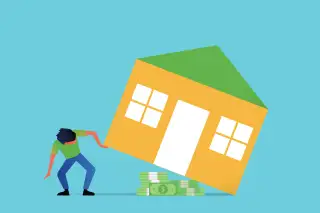Millions of Americans Need Cash — But Borrowing Against Your Home Is Getting Tougher

With the U.S, economy shut down, and millions unemployed, now might seem like the perfect time to tap your home for emergency cash. But it's not as simple as it looks.
About 45 million homeowners are sitting on real estate equity worth $6.3 trillion. That works out to about $140,000 per borrower—money that could come in very handy for paying bills during the coronavirus crisis.
But potential home equity borrowers won’t find it as easy to borrow as they might have before the COVID-19 pandemic. Lenders are tightening their credit standards, particularly with regard to home equity lines of credit, or HELOCs, and home equity loans. “They’re worried about getting repaid,” says Ralph McLaughlin, chief economist at the San Francisco-based lender Haus.
How a HELOC Works
A HELOC or home equity loan is a second loan against a property. As such, if the borrower runs out of money and the home is foreclosed on and sold, the lender is second in line to get paid, after the primary mortgage lender. Getting paid second, McLaughlin says, might mean not getting paid at all—especially if home prices fall.
McLaughlin says that major banks have taken three steps to tighten their home equity lending. First, they’ve raised their credit score requirements from the mid 600s to 700 or above. Instead of credit that’s just good, potential borrowers need excellent credit to qualify for a loan.
Second, banks are reducing the sums that they’re willing to lend through a HELOC or home equity loan. The previous upper limit might have been around $250,000. Now the ceiling is at $150,000, $100,000, or even lower.
Third, in addition to lowering the nominal sums they’re lending, banks are also willing to lend a smaller percentage of home equity than before the pandemic. “They’ve gone from 80 percent to 85 percent, down to between 70 percent and 80 percent,” McLaughlin says. Leaving more equity in the home makes it more likely that, if the borrower defaults, both the first and second leinholders will get paid.
A cash-out refinance is still an option for many borrowers, but here, too, lending guidelines are more stringent. “All lenders are looking more closely to see if someone is already in forbearance and whether borrowers have jobs,” says CD Davies, head of lending at Figure, a lender based in San Francisco. In the past, he says, verification of employment happened shortly after application. Now borrowers can expect verification of employment within 48 hours of closing.
Borrowers can’t stop the pandemic or economic downturn, but there are things they can do to make getting a HELOC or home equity line easier. “Reduce or eliminate your credit card balances,” McLaughlin says. Keep your application relatively modest in both absolute and percentage terms. “Banks are more nervous if you ask for a large amount than if you ask for a smaller one,” he says. In your loan application, make a case for why you or your partner is likely to stay employed.
Perhaps most of all, McLaughlin says, be patient. “Lenders are flooded with loan applications right now.”
More from Money:
30-Year Mortgage Rates Are Back Near Record Lows — For Some Borrowers
The CARES Act Makes It Easier To Withdraw from Your 401(k). Here's What to Know Before You Do